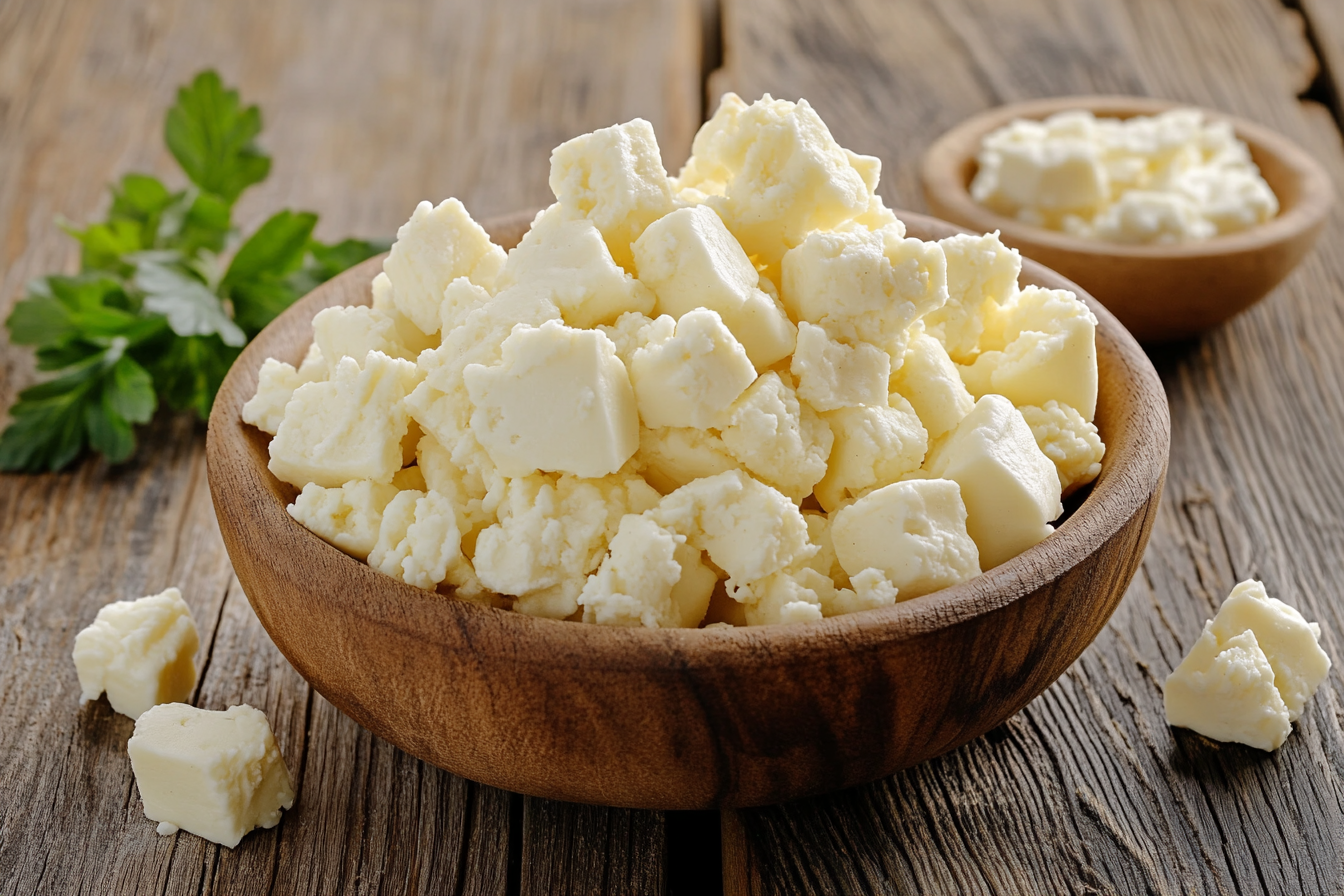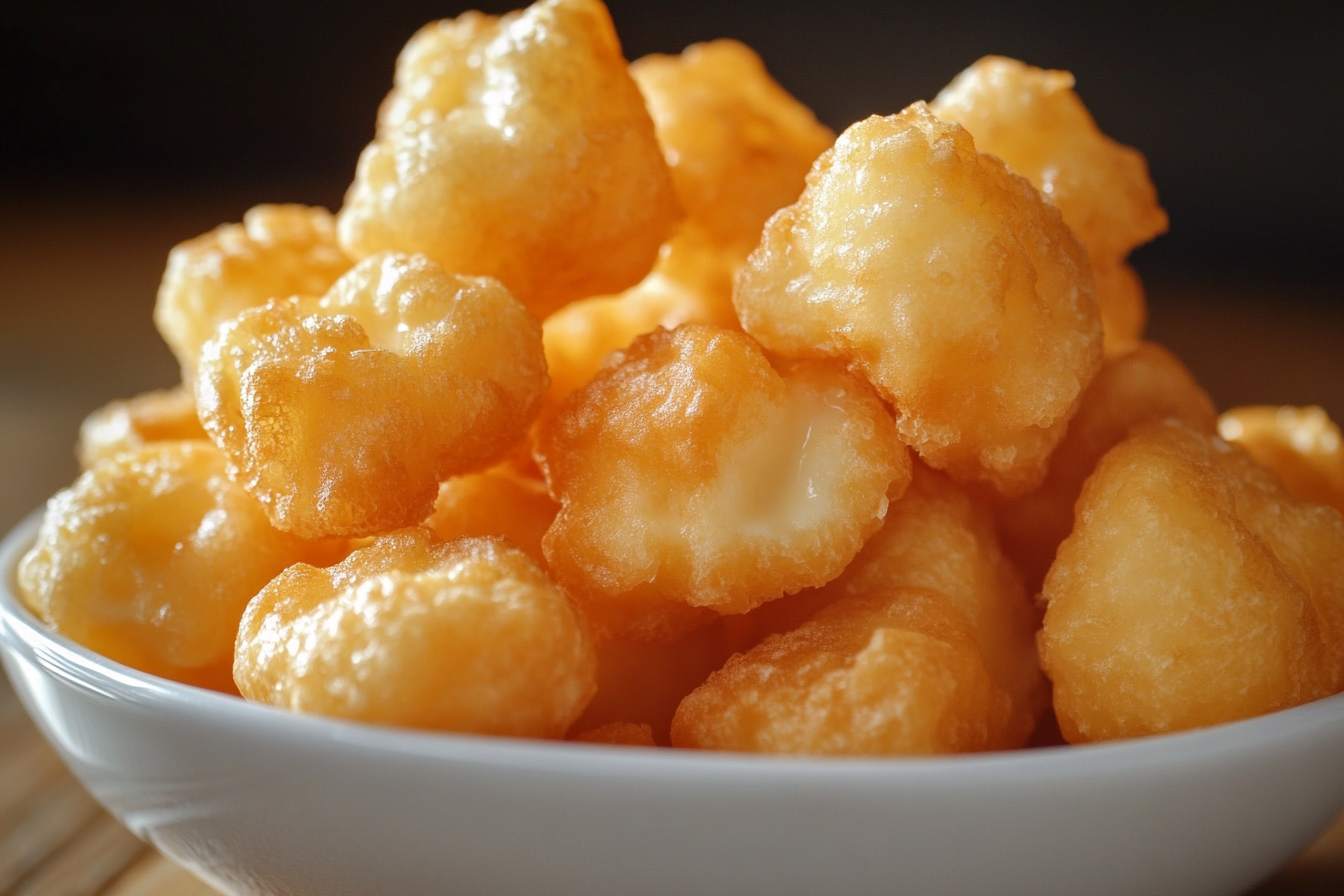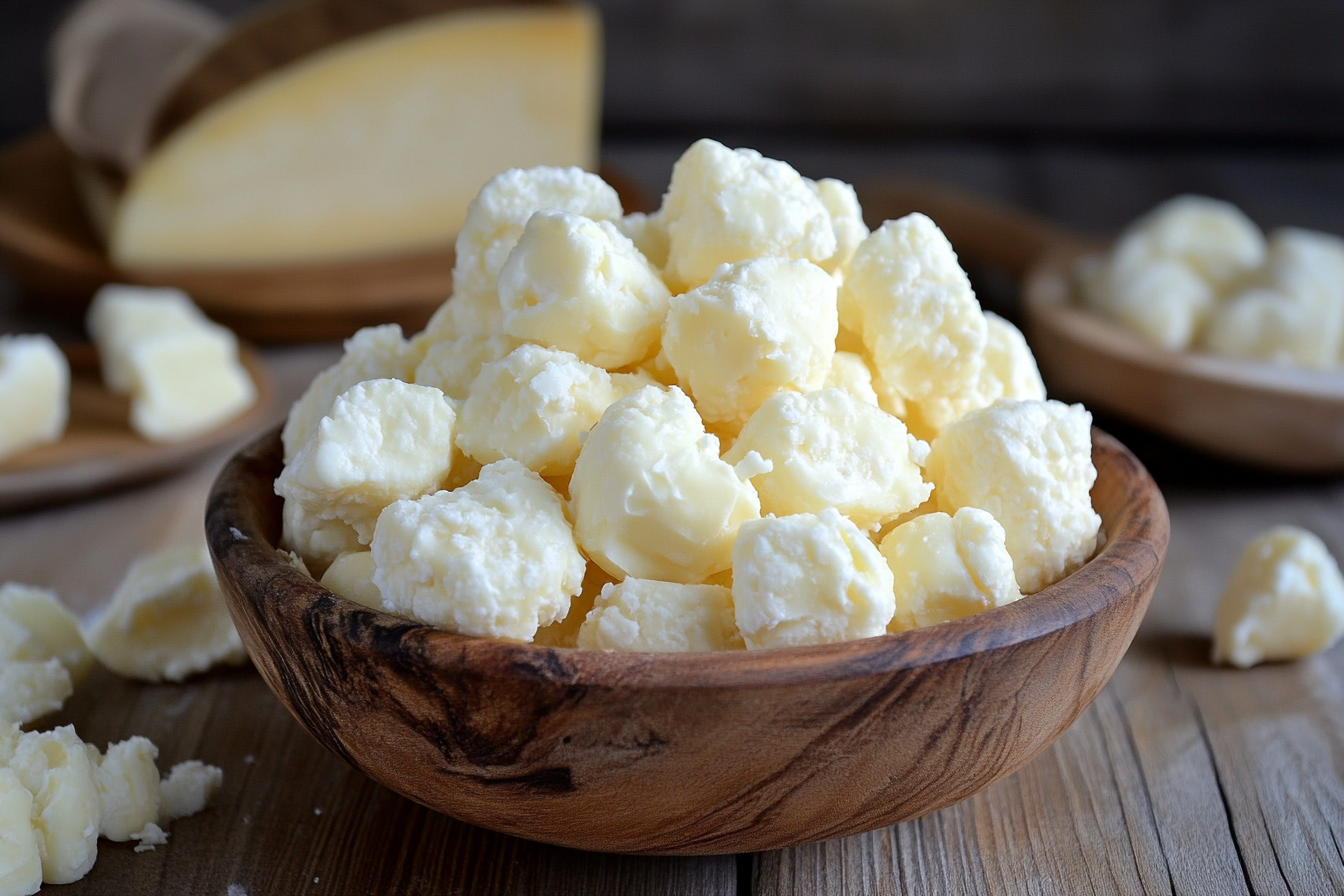Cheese curds offer a fresh, squeaky experience that cheese lovers, especially in Wisconsin and Quebec, find irresistible. These small, solid pieces of curdled milk are more than just a byproduct of cheese-making; they are a beloved food item with a unique texture and mild flavor. This article will explore everything from the basics of cheese curds to their culinary uses and nutritional benefits.
What Are These Squeaky Treats?
Cheese curds form when milk curdles during the cheese-making process. During curdling, the liquid whey separates from the solid curds. Unlike aged cheeses, curds are often enjoyed fresh, right after they’re made, which gives them their signature squeak when bitten into.
Fresh curds are known for their firm, slightly springy texture and mild, tangy flavor. Their squeak, a sign of freshness, adds to their appeal as a unique culinary experience.
The Science Behind the Squeak
The squeaky texture of fresh cheese curds isn’t just a novelty; it’s a sign of quality. The curds’ protein structure is responsible for this characteristic sound. When curdling occurs, proteins (mainly casein) form a network that traps fat and moisture, resulting in a firm yet elastic texture. Biting into a fresh curd causes these protein strands to rub together, producing the squeaking sound.
As curds age, they lose moisture, and their protein structure changes, which reduces their elasticity and the intensity of the squeak. This squeakiness, directly linked to freshness, is why cheese curds are best enjoyed soon after they are made. If you’re curious about the science behind these delicious treats, this detailed guide provides more insights.
How Are These Dairy Delights Made?

The creation of cheese curds involves several precise steps that contribute to their final texture and flavor. Here’s a closer look at how these tasty morsels come to life:
- Milk Preparation: The process begins with fresh milk, typically sourced from cows, goats, or sheep. This milk is heated to a specific temperature to prepare it for curdling.
- Curdling Process: Rennet, an enzyme, is added to the heated milk to start the curdling process. This separates the milk into solid curds and liquid whey. The curds are allowed to rest, forming a thick mass ready for the next step.
- Cutting the Curds: The curds are then cut into smaller, uniform pieces using specialized tools. The size of these pieces affects the final texture—larger curds retain more moisture and are softer, while smaller curds are firmer.
- Cooking and Stirring: After cutting, the curds are gently heated and stirred. This process helps expel additional whey, further firming up the curds. Stirring also prevents the curds from clumping together, ensuring they remain separate and maintain their distinct texture.
- Draining the Whey: Once the curds reach the desired firmness, the remaining whey is drained. Properly draining the whey ensures the curds have the right moisture content. Excess moisture can make them too soft, while too little can make them dry.
- Salting the Curds: The curds are then lightly salted to enhance their flavor and help preserve them. The amount of salt can vary depending on regional preferences and the intended use of the curds.
- Packaging and Distribution: Finally, the curds are packaged for sale or consumption. Because they are best when fresh, curds are often packaged and distributed quickly, sometimes within hours of being made.
If you’re interested in trying your hand at making cheese curds at home, this tutorial offers step-by-step instructions.
Delicious Ways to Enjoy Fresh Curds
Cheese curds are versatile and can be used in various dishes, both savory and sweet. Their mild flavor and unique texture make them a popular choice for many recipes. Here are some popular ways to enjoy them:
The Classic Poutine
One of the most famous dishes featuring cheese curds is poutine, a Canadian favorite that has gained popularity worldwide. Poutine consists of crispy French fries topped with fresh curds and smothered in rich, savory gravy. The combination of textures—crunchy fries, squeaky curds, and velvety gravy—creates a dish that is both comforting and indulgent.
If you’re interested in exploring different versions of poutine, this article offers insights into how this dish can be adapted to suit various tastes.
Fried Cheese Curds
In the United States, particularly in the Midwest, fried cheese curds are a beloved snack. The curds are coated in a light batter and deep-fried until golden brown, resulting in a crispy exterior that encases warm, gooey curds. These fried treats are often served with dipping sauces like ranch or marinara, making them a popular appetizer at restaurants and fairs.
Adding to Salads and Main Dishes
Cheese curds can also be used to add texture and flavor to salads and main dishes. In salads, they pair well with fresh greens, tomatoes, and a light vinaigrette. As a topping for baked potatoes, curds blend perfectly with sour cream, chives, and bacon, creating a rich and satisfying dish. Additionally, they can be incorporated into casseroles or used as a topping for pizzas, adding an extra layer of cheesy goodness.
For more creative ways to incorporate cheese curds into your meals, check out these cheese curd recipes that explore various culinary applications.
The Cultural Importance of Curds
Cheese curds are enjoyed globally, but they hold special cultural significance in regions like Wisconsin and Quebec.
Wisconsin’s Dairy Heritage
Wisconsin, often referred to as the “Dairy State,” has a rich history and thriving dairy industry. Cheese curds, a natural byproduct of the state’s extensive cheese-making operations, have become a beloved local delicacy. In Wisconsin, people celebrate curds with festivals, events, and specialty shops dedicated to selling fresh curds.
Many visitors to Wisconsin seek out fresh cheese curds, available at farmers’ markets, local cheese shops, and even some gas stations. The state’s deep connection to these squeaky treats is evident in the variety of ways they are enjoyed, from simple snacks to deep-fried delights.
Quebec and the Birth of Poutine
In Quebec, cheese curds play a crucial role in poutine, a dish that has become a symbol of Canadian cuisine. Poutine originated in rural Quebec in the 1950s and quickly became a popular comfort food. Today, poutine is enjoyed across Canada and beyond, with countless variations that include everything from pulled beef to foie gras.
Fresh curds are essential in poutine, as their mild flavor and squeaky texture perfectly complement the rich gravy and crispy fries. In Quebec, poutine represents more than just a dish—it stands as a cultural icon that has put these curds on the global culinary map.
Nutritional Benefits of Cheese Curds
Cheese curds offer not only a delicious taste but also several nutritional benefits. They are an excellent source of calcium, essential for maintaining strong bones and teeth. Additionally, cheese curds are rich in protein, supporting muscle repair and growth, making them a valuable addition to a balanced diet.
Curds also contain essential vitamins such as vitamin A, which supports vision and immune function, and vitamin B12, which is vital for energy production and neurological health. However, it’s important to note that curds are high in fat, particularly saturated fat. While these fats play roles in various bodily functions, moderation is key, especially if you are monitoring your fat intake.
For more information on the health benefits of dairy products, including cheese curds, this guide offers valuable insights.
Storing Cheese Curds for Freshness
Cheese curds are best enjoyed fresh, but proper storage is essential to maintain their flavor and texture if you have leftovers. Here’s how to store them effectively:
- Refrigeration: Store cheese curds in an airtight container in the refrigerator. This will help preserve their freshness for up to a week. However, for the best squeak, consuming them within a few days is recommended.
- Freezing: While freezing is not ideal for curds (as it can affect their texture), it is an option if you need to store them for a longer period. To freeze, place the curds in a single layer on a baking sheet and freeze them until solid. Then, transfer the frozen curds to an airtight container or freezer bag. Thaw the curds in the refrigerator before eating, though be aware that the texture may change slightly.
Where to Purchase Fresh Curds
If you’re not in a dairy-producing region, finding fresh cheese curds can be challenging. However, there are several options for purchasing these treats, both in-store and online:
- Specialty Cheese Shops: Many specialty cheese shops carry fresh curds, especially in areas known for dairy production. These shops often source their curds from local producers, ensuring freshness and quality.
- Farmers’ Markets: Fresh, locally produced curds are often available at farmers’ markets. Buying from a farmers’ market supports local agriculture and gives you access to some of the freshest curds available.
- Online Stores: Some dairies and specialty food retailers offer curds for sale online, with shipping options that allow you to enjoy fresh curds no matter where you live. When purchasing online, look for sellers who prioritize freshness and offer expedited shipping to ensure the curds arrive in peak condition.
For those who prefer to make their own cheese curds, this tutorial on homemade cheese curds provides a step-by-step guide.
FAQs About Cheese Curds
What are cheese curds made of?
Cheese curds form from curdled milk, a byproduct of the cheese-making process. They are the solid pieces that result after the liquid whey is separated from the milk.
Can you eat curds raw?
Yes, curds are often eaten raw and are especially enjoyed fresh for their unique squeaky texture.
How long do curds last?
Cheese curds are best consumed fresh, within a few days. As they age, they lose their characteristic squeakiness and become firmer.
Why are curds so popular in Wisconsin?
Wisconsin is a major dairy producer, and curds naturally result from the state’s extensive cheese-making industry. They are celebrated as a local delicacy and are widely available across the state.
What makes curds different from regular cheese?
Cheese curds are fresh, unaged pieces of cheese, whereas regular cheese is typically aged and has a different texture and flavor profile.
How can I store curds to keep them fresh?
To keep cheese curds fresh, store them in an airtight container in the refrigerator. They are best eaten within a few days, as they will lose their squeakiness over time. If you want to enjoy them for longer, you can freeze them, but be aware that freezing can alter their texture.
Creative Ways to Use Curds in Cooking
Cheese curds are not only a tasty snack but also a versatile ingredient that can be used in various dishes. Here are some creative ways to incorporate curds into your cooking:
- Mac and Cheese: Add curds to your favorite mac and cheese recipe for an extra layer of texture and flavor. The curds will melt slightly but still retain some of their squeakiness, making for a delicious twist on this classic dish.
- Grilled Cheese Sandwiches: Swap out your usual cheese for curds in a grilled cheese sandwich. The curds will melt to a gooey consistency, while still providing that signature squeak with every bite.
- Salads: Toss curds into a fresh salad for added protein and a satisfying texture. They pair especially well with greens, tomatoes, and a light vinaigrette.
- Pizza Topping: Use curds as a topping for homemade pizza. They will melt and become slightly gooey, adding a unique twist to your favorite pizza recipes.
For more inspiration on incorporating curds into your meals, check out this guide on pizza variations, which offers some delicious ideas to satisfy your cravings.
Conclusion
Cheese curds provide a fresh and delightful experience unlike any other form of cheese. Whether enjoyed as a snack, in dishes like poutine, or as an ingredient in various recipes, curds offer a mild flavor and squeaky texture that make them a favorite for many. Their cultural significance in regions like Wisconsin and Quebec only adds to their charm, making them a must-try for any cheese lover.

